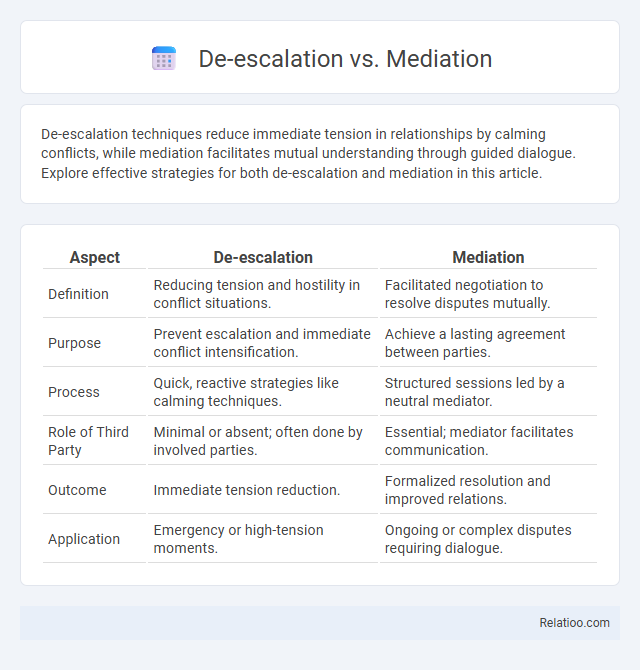De-escalation techniques reduce immediate tension in relationships by calming conflicts, while mediation facilitates mutual understanding through guided dialogue. Explore effective strategies for both de-escalation and mediation in this article.
Table of Comparison
| Aspect | De-escalation | Mediation |
|---|---|---|
| Definition | Reducing tension and hostility in conflict situations. | Facilitated negotiation to resolve disputes mutually. |
| Purpose | Prevent escalation and immediate conflict intensification. | Achieve a lasting agreement between parties. |
| Process | Quick, reactive strategies like calming techniques. | Structured sessions led by a neutral mediator. |
| Role of Third Party | Minimal or absent; often done by involved parties. | Essential; mediator facilitates communication. |
| Outcome | Immediate tension reduction. | Formalized resolution and improved relations. |
| Application | Emergency or high-tension moments. | Ongoing or complex disputes requiring dialogue. |
Understanding De-escalation: Key Concepts
Understanding de-escalation involves recognizing verbal and non-verbal techniques aimed at reducing tension and preventing conflict escalation in high-stress situations. Unlike mediation, which requires the involvement of a neutral third party to facilitate negotiation between disputing parties, de-escalation focuses on immediate interpersonal interactions to calm emotions and promote safety. Key concepts include active listening, empathetic communication, maintaining calm body language, and creating an environment that discourages aggression and supports constructive dialogue.
Defining Mediation: Core Principles
Mediation centers on facilitating communication and negotiation between conflicting parties to reach a mutually acceptable agreement, emphasizing neutrality and confidentiality. Core principles include voluntary participation, impartiality of the mediator, and a structured process that empowers Your voice while respecting all perspectives. Unlike de-escalation, which aims at reducing immediate tension, mediation seeks long-term resolution through collaborative problem-solving.
Differences Between De-escalation and Mediation
De-escalation involves immediate techniques to reduce tension and prevent conflict from escalating, often used in crisis or emergency situations. Mediation is a structured process facilitated by a neutral third party aimed at resolving conflicts through dialogue and negotiation between disputing parties. Unlike mediation, which seeks long-term resolution and agreement, de-escalation focuses on short-term calming and safety without necessarily addressing the root causes of conflict.
When to Use De-escalation Techniques
De-escalation techniques are most effective during situations of rising tension or conflict where emotions are intense, aimed at calming parties before the dispute escalates further. Unlike mediation, which is suitable once both sides are willing to engage in structured dialogue, de-escalation immediately reduces aggression and prevents violence or breakdown in communication. Your ability to recognize early signs of conflict and apply de-escalation can transform potentially volatile encounters into opportunities for constructive conversation.
Situations Ideal for Mediation
Situations ideal for mediation involve conflicts where parties seek a mutually acceptable resolution through facilitated communication, often in workplace disputes, family disagreements, or contractual issues. Your role as a mediator is to guide open dialogue and ensure that all voices are heard, promoting collaborative problem-solving rather than unilateral decision-making. De-escalation is better suited for immediate reduction of tension in high-stress moments, while arbitration involves a third party imposing a binding decision.
Essential Skills for Effective De-escalation
Essential skills for effective de-escalation include active listening, emotional regulation, and clear communication, which help reduce tension and prevent conflict escalation. Unlike mediation, which involves a neutral third party facilitating resolution between disputing parties, de-escalation focuses on calming individuals in real-time to avoid further agitation. Mastery of empathy and patience enables responders to defuse potentially volatile situations swiftly and maintain safety.
Key Mediation Strategies for Conflict Resolution
Key mediation strategies for conflict resolution include active listening, which ensures all parties feel heard and understood, and reframing, which helps to shift perspectives from adversarial to collaborative. Mediators employ interest-based negotiation techniques to uncover underlying needs, promoting mutually beneficial agreements. Additionally, establishing clear communication guidelines and encouraging empathy are essential to de-escalate tensions and maintain constructive dialogue throughout the mediation process.
Outcomes: De-escalation vs Mediation Results
De-escalation techniques primarily aim to reduce immediate tension and prevent conflict escalation, leading to quicker resolution in high-stress situations but often without addressing underlying issues. Mediation focuses on facilitating communication between parties to reach a mutually acceptable agreement, resulting in more sustainable and long-term conflict resolution. Outcomes of de-escalation tend to be short-term stability, while mediation outcomes include enhanced understanding, improved relationships, and durable agreements.
Benefits and Limitations of Each Approach
De-escalation reduces immediate tension by calming emotions and preventing conflict from escalating, benefiting urgent situations but limited by its short-term scope and reliance on emotional control. Mediation facilitates structured dialogue between parties to achieve a mutually agreeable resolution, offering long-term conflict management but requiring willingness and cooperation from all involved. Your choice depends on whether the conflict demands quick emotional management, collaborative problem-solving, or a combination of strategies to address both immediate and underlying issues.
Choosing the Right Method for Managing Conflict
Choosing the right method for managing conflict depends on the situation's intensity and the parties involved. De-escalation techniques prioritize calming immediate tensions through non-threatening communication and body language, suitable for volatile scenarios. Mediation involves a neutral third party facilitating dialogue and negotiation, ideal for structured, long-term resolutions where both sides seek mutual agreement.

Infographic: De-escalation vs Mediation
 relatioo.com
relatioo.com